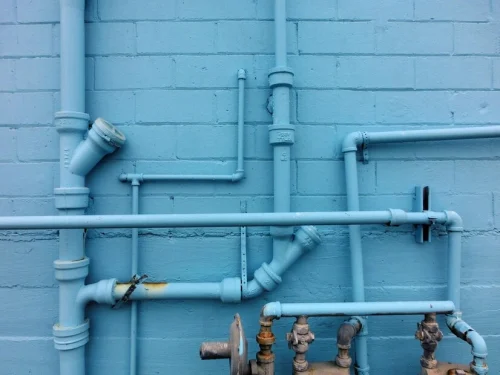
Pea Gravel Uncovered: How It’s Made, What It Costs & Where to Use It
April 24, 2025
Epoxy Flooring Cost per Sq Ft in India: Rates & Factors
April 24, 2025When building a home, you probably focus on the big things—the layout, the design, the colors, and the furniture. What’s behind the walls matters more than you think. Plumbing often gets overlooked, but it plays a key role in making your space comfortable and functional every day.
Imagine a house without running water, without proper waste disposal, or even without hot showers. It would quickly become unlivable. Yet, it is often the last thing on homeowners' minds when they start on a construction journey.
In this guide, we’ll dive into the details of plumbing work in house, explore how to plan and install them.
The Backbone of the House
In any home, the plumbing system is like the circulatory system in a body. It comprises a network of pipes, valves, fixtures, and fittings that facilitate the distribution of clean water and the removal of wastewater.
Key components include:
- Water Supply Lines: These pipes carry clean, potable water from the water source (municipal supply or well) to faucets, showers, toilets, and other water-using appliances in the house.
- Drainage Pipes: These pipes carry wastewater away from the home to a septic tank or municipal sewer system.
- Vent Pipes: Often overlooked, these pipes play a crucial role in maintaining air pressure within the plumbing system. Vent pipes help water to flow freely through drainage pipes by preventing airlocks and ensuring proper drainage.
- Fixtures: Fixtures, such as sinks, showers, bathtubs, and toilets, are the visible components of a building plumbing work. These fixtures are designed to either use water or dispose of it safely.
Understanding these elements is crucial for effective home plumbing work.
Planning is Everything
Effective planning is the cornerstone of successful plumber work in house construction. It involves:
- Blueprint Analysis: Assessing architectural plans to determine optimal pipe routes.
- Load Calculations: Ensuring pipes can handle the expected water flow and pressure.
- Fixture Placement: Strategically locating fixtures for efficiency and convenience.
- Code Compliance: Adhering to local building codes and regulations to ensure safety and legality.
A well-thought-out plan minimizes future issues and facilitates smoother construction processes.
Water Supply Lines
Water supply lines are responsible for delivering clean water throughout the house. Common materials used include:
PEX (Cross-linked Polyethylene): PEX is flexible, durable, and used for both hot and cold water lines.
Copper: Copper is strong, resists corrosion, and works well in homes with hard water.
PVC (Polyvinyl Chloride): PVC is lightweight, affordable, and best for cold water lines only.
Proper installation involves:
- Correct Sizing: Ensuring pipes are appropriately sized to maintain water pressure.
- Secure Connections: Using suitable fittings and techniques to prevent leaks.
- Insulation: Protecting pipes from temperature extremes to prevent freezing or condensation.
Attention to these details ensures a reliable and efficient water supply system.
Drainage and Waste Systems
The drainage system, also known as the Drain-Waste-Vent (DWV) system, is crucial for removing wastewater and preventing sewer gases from entering the home. Key components include:
- Drain Pipes: Drain pipes remove wastewater from sinks, toilets, and showers, directing it to the sewer or septic tank. They're laid at a gentle slope so water flows out smoothly without backups.
- Vent Pipes: Vent pipes let air into the plumbing system so water drains properly. They also push sewer gases safely outside instead of letting them creep into your home.
- Traps: Traps are U-shaped pipes under sinks and toilets that hold water to block bad smells from the drain. They’re small but essential for keeping indoor air clean.
- Backflow Prevention: Backflow happens when dirty water flows back into clean lines due to pressure changes. Installing check valves helps stop this and keeps your water safe.
Proper slope and venting are essential to ensure efficient drainage and prevent issues such as slow drains or unpleasant odours.
Safety Measures and Code Compliance
Adhering to safety standards and building codes is paramount in plumbing work in house. In India, relevant codes include:
- IS 1172: Code of Basic Requirements for Water Supply, Drainage, and Sanitation.
- IS 1742: Code of Practice for Building Drainage.
- IS 5329: Code of Practice for Sanitary Pipe Work Above Ground.
Compliance ensures:
- Health and Safety: Preventing contamination and ensuring a safe water supply.
- Structural Integrity: Avoiding damage to the building from leaks or improper installations.
- Legal Adherence: Meeting legal requirements to avoid penalties or reconstruction.
Regular inspections and adherence to these codes are essential for a safe and functional plumbing system.
What Can Go Wrong?
Even with meticulous planning, issues can arise in home plumbing work. Common problems include:
- Leaks: Leaks happen when pipes or joints are damaged or poorly installed, leading to water damage.
- Clogs: Clogs are caused by buildup of hair, grease, or soap, blocking water flow in drains.
- Water Hammer: Water hammer is a banging noise in pipes caused by sudden changes in water flow.
- Backflow: Backflow allows dirty water to enter clean lines during pressure drops, but can be prevented.
Addressing these issues promptly is crucial to prevent further damage and maintain the integrity of the plumbing work in the house.
Final Thoughts
Did you know? A single leaky tap can waste over 3,000 gallons of water a year. That’s not just bad for the planet, it’s money literally going down the drain. That’s why smart plumbing choices matter way more than we usually think.
From clean water to safe drainage, good plumbing keeps your daily life running smoothly. So, while it may be hidden behind walls, it deserves just as much attention as the stuff you can see.
Plan it well, do it right, and you won’t have to think about it again for years.
Enhance Your Home with Green Fortune
Green Fortune offers a diverse range of customizable uPVC products, including casement windows, sliding windows, French windows, and more. With over 25 years of expertise in the building materials industry, we provide tailored solutions to meet your specific needs.
To explore our offerings and check for yourself how Green Fortune can transform your home, visit their official website: Green Fortune.
FAQs
Q1: How often should plumbing systems be inspected?
It's recommended to have your plumbing system inspected annually to identify potential issues early and ensure everything is functioning correctly. Regular inspections can prevent costly repairs and extend the lifespan of your plumbing components. Professional plumbers can provide comprehensive assessments and maintenance services.
Q2: Can I perform plumbing work myself?
While minor tasks like unclogging drains can be DIY, major plumbing work in house should always be handled by professionals. Incorrect installations can lead to leaks, code violations, and even structural damage. Hiring a licensed plumber ensures compliance, safety, and long-term reliability.
Q3: What is the lifespan of plumbing materials?
PEX lasts around 40–50 years, copper up to 70+ years, and PVC around 25–40 years under ideal conditions. Environmental factors, water quality, and usage patterns can affect longevity. Regular maintenance helps extend the lifespan regardless of the material.











